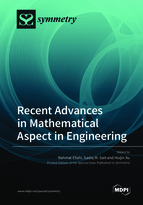Recent Advances in Mathematical Aspect in Engineering
A special issue of Symmetry (ISSN 2073-8994). This special issue belongs to the section "Computer".
Deadline for manuscript submissions: closed (31 December 2020) | Viewed by 25108
Special Issue Editors
2. Chair Professor, Center for Modeling & Computer Simulation, Research Institute, King Fahd University of Petroleum & Minerals, Dhahran 31261, Saudi Arabia
3. Department of Mathematics, International Islamic University, Islamabad 44000, Pakistan
Interests: nanofluid; non-newtonian fluid; heat and mass transfer; porosity; MHD; peristaltic; blood flow
Special Issues, Collections and Topics in MDPI journals
Interests: optimization; energy; numerical computation; mathematical problem in engineering; nanodevices
Interests: heat and mass transfer; transport in porous media; thermal storage; carbon capture
Special Issues, Collections and Topics in MDPI journals
Special Issue Information
Dear Colleagues,
This Issue invites you to present your latest original research findings, review articles, and short communications which are either advances in the state-of-the-art of mathematical methods, theoretical studies, or experimental studies that extend the bounds of existing methodologies to new contributions addressing current challenges and engineering problems. We hope that this Issue will serve as a platform for innovation and will provide up-to-date findings to readers and the scientific community.
All papers will be peer-reviewed. Accepted papers will be published and will appear immediately on the Special Issue website. Please note that all submitted papers must be within the general scope of the Symmetry journal.
Scope: Potential topics dealing with (but not limited to) the following subheadings are deemed suitable for publication:
- Fluid mechanics;
- Optimization;
- Energy;
- Heat transfer;
- Steady and unsteady flow problems;
- Porosity;
- Nanofluids;
- Particle shape effects;
- Multiphase flow;
- Thermodynamics;
- Magnetohydrodynamics;
- Electromagnetic;
- Physiological fluid phenomena in biological systems;
- Peristaltic;
- Blood flow.
Dr. Rehmat Ellahi
Prof. Dr. Sadiq M. Sait
Prof. Dr. Huijin Xu
Guest Editors
Manuscript Submission Information
Manuscripts should be submitted online at www.mdpi.com by registering and logging in to this website. Once you are registered, click here to go to the submission form. Manuscripts can be submitted until the deadline. All submissions that pass pre-check are peer-reviewed. Accepted papers will be published continuously in the journal (as soon as accepted) and will be listed together on the special issue website. Research articles, review articles as well as short communications are invited. For planned papers, a title and short abstract (about 100 words) can be sent to the Editorial Office for announcement on this website.
Submitted manuscripts should not have been published previously, nor be under consideration for publication elsewhere (except conference proceedings papers). All manuscripts are thoroughly refereed through a single-blind peer-review process. A guide for authors and other relevant information for submission of manuscripts is available on the Instructions for Authors page. Symmetry is an international peer-reviewed open access monthly journal published by MDPI.
Please visit the Instructions for Authors page before submitting a manuscript. The Article Processing Charge (APC) for publication in this open access journal is 2400 CHF (Swiss Francs). Submitted papers should be well formatted and use good English. Authors may use MDPI's English editing service prior to publication or during author revisions.








